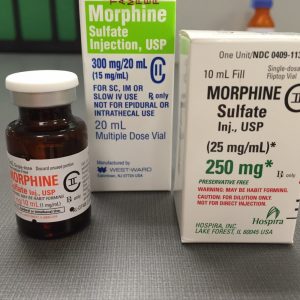Some sources say that this opiate is not as potent as heroin or fentanyl. These three belong in the opioid family. They are usually used to treat severe pain from heart attack and cancer.
This opioid painkiller can either be slow- or fast-acting, depending on what’s recommended by your doctor. For a fast-acting type, you will start feeling the effects in 30 to 60 minutes after your last intake. For a slow-acting type, it takes around one to two days for you to feel its pain-relieving effects.
Besides its medicinal effects, it induces a euphoric feeling, which is the reason for abuse among patients. For you to avoid being addicted, you need to follow your doctor’s prescription.
In this read, let’s know more about how this opiate works on your body and its corresponding side effects.
Who Can and Cannot Take Morphine?
Not everyone can take advantage of the medicinal effects of this painkiller, especially for babies and the elderly. Before taking this opiate, here are some health conditions which can prohibit you from taking this drug:
 Head trauma
Head trauma- If you are pregnant or trying to get pregnant
- You have a sickness that causes your muscles to get weak
- Benign prostate enlargement
- Low blood pressure
- You experience episodes of seizures
- You are diagnosed with alcohol use disorder
- Lung problems
- Allergies to opioids
- Disease on your adrenal glands, kidneys, and liver
Be sure to disclose any medical history to your doctor if you’re planning on taking this drug.
How and When Do You Take Morphine?
Generally, you take this opioid painkiller after a meal or snack so that you don’t feel ill or weak. Here are the different types of this drug and their corresponding strengths:
Slow-Acting
This can either be in tablets or capsules, which are orally ingested. For the tablets, it comes in various potencies: 5mg, 10mg, 15mg, 30mg, 60mg, 100mg, and 200mg. For capsules, its available strengths are the following: 10mg, 30mg, 60mg, 90mg, 120mg, 150mg, and 200mg.
Fast-Acting
This drug can take effect in 30 to 60 minutes after your last dose. It also comes in different potencies: 10mg, 20mg, and 50mg tablets.
Granular
This type is in granule form and needs to be dissolved in water, and then you drink it up. The sachets come in different strengths: 30mg, 60mg, 100mg, and 200mg.
Syrup
This is a liquid form of the drug, and it comes in two strengths:
- 10 mg per 5ml liquid
- 20 mg per 1ml liquid
Suppositories and Injection
If you cannot swallow the tablet or pill, or your stomach cannot handle the drug, you can opt for a suppository. A 10 mg suppository drug is available in the market for your medication.
Injectables or IV transmission of this drug can be done inside the hospital by trained medical personnel.
This type of opiate is fast-acting, so you can readily feel its effects in less than an hour. The pain-relieving effect only lasts for a short time, that’s why it’s mostly used for the first time to find the right dose for you.
How Many Times Do You Need To Take Morphine?
Typically, your doctor will advise you to take like 2 or 3 times of this drug daily for a specific number of days.
It’s also recommended that you take your medicine at a constant time daily. For instance, you need to take two tablets a day. You can take the first tablet at 9 am and then the second one at 6 pm. Once you start with this schedule, stick to it so that you make that a habit and you can regularly observe the effects.
Here are some doses prescribed by doctors for using this drug:
- Take fast-acting pills and tablets 4-6 times daily
- Suppositories and Liquids are taken 4-6 times daily
- Injectables are done 4-6 times daily inside the hospital
- Slow-acting tablets, granules, and pills are taken 1-2 times daily
What should I tell my physician before I take Morphine?
First, are you pregnant or nursing a baby?
 This opioid poses a great danger to your child while you are pregnant. Your newborn will be dependent on morphine and may need treatment for several weeks. They may also develop withdrawal symptoms which could be fatal.
This opioid poses a great danger to your child while you are pregnant. Your newborn will be dependent on morphine and may need treatment for several weeks. They may also develop withdrawal symptoms which could be fatal.
If you are nursing your baby, you will be required to stop breastfeeding as the morphine could mix up in your breastmilk and may cause drowsiness, breathing issues, or even death to your baby.
Second, are you allergic to narcotic medicines such as morphine?
You are not allowed to take opiate medication if you are allergic to narcotic medicines, or even if you have severe asthma or breathing problems, and a blockage in your stomach or intestines.
Third, have you used an MAO inhibitor in the past 14 days?
The drug’s interaction with other medicines could be dangerous. MAO inhibitors include the following:
- Isocarboxazid
- Linezolid
- Methylene blue injection
- Phenelzine
- Rasagiline
- Selegiline
- Tranylcypromine
Lastly, have you suffered from any of the following?
- Breathing problems or sleep apnea
- A head injury, brain tumor, or seizures
- A drug or alcohol addiction or mental illness
- Urination problems
- Liver or kidney disease
- Pancreatitis
Medicating with this drug requires a thorough assessment of the patient before it is prescribed. Be honest with your doctor so you won’t experience severe complications.
Keep in mind that IV medication of this opiate should also not be administered to anyone younger than 18 years old.
How Can Morphine Be Safely Administered?
 First, follow the prescription given by your physician and read and understand carefully all medication guides. Remember that taking large doses of the drug is dangerous. Make sure to tell your doctor if you feel the urge to use more of this medicine.
First, follow the prescription given by your physician and read and understand carefully all medication guides. Remember that taking large doses of the drug is dangerous. Make sure to tell your doctor if you feel the urge to use more of this medicine.
Second, never share your medicine with another person, especially those with a history of substance abuse. Keep it in a place where no one else can get it but you. Remember that selling or giving away this opioid is against the law.
Third, do not suddenly stop taking it. The risks of withdrawal can occur in at least 12 hours. Physician-assisted withdrawal treatment is necessary for cutting back from using morphine to avoid severe complications. In case you miss a dose, take it as soon as you remember but make sure you don’t take two tablets at a time. Give a 3-hour space apart. When in doubt, always seek advice from your physician.
You must also talk to your physician when you experience the following:
- Fainting
- Chest pain
- Trouble breathing
- Swelling
- Throat tightness
- Seizures
- Abdominal soreness or tenderness
- Rash
- Itching
- Vomiting
- Constipation
Nausea can be common when under morphine medication and can be relieved once you eat. If you have eaten and you still feel nauseous, call your doctor immediately.
The danger of morphine medication could be fatal but with proper supervision by your healthcare provider and your sense of focus, addiction, overdose, and death can be prevented.
If you or any of your family members are abusing this drug, you need to intervene and help them gain awareness of their condition. After that, convince them to talk to a doctor or addiction specialist for their treatment program.